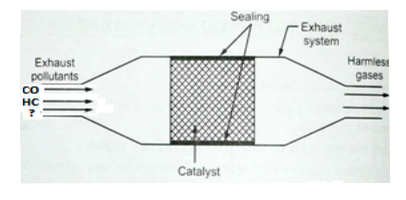Name two metals used in a catalytic converter. How do they help in keeping the environment clean ?
Step-by-Step Solution:
1. Identify the Metals Used in Catalytic Converters:
The two primary metals used in catalytic converters are platinum (Pt) and palladium (Pd). These metals are classified as precious metals and serve as catalysts in the conversion process.
2. Understand the Role of Catalysts:
Catalysts are substances that speed up chemical reactions without being consumed in the process. In catalytic converters, platinum and palladium facilitate the conversion of harmful gases into less harmful substances.
3. Explain How They Help Keep the Environment Clean:
- Reduction of Emissions: Catalytic converters help reduce the emission of poisonous gases from vehicles. They convert unburned hydrocarbons (HC) into carbon dioxide (CO2) and water (H2O).
- Conversion of Carbon Monoxide and Nitric Oxide: They also convert carbon monoxide (CO), a toxic gas, and nitric oxide (NO), a harmful pollutant, into carbon dioxide (CO2) and nitrogen gas (N2), which are less harmful to the environment.
4. Summarize the Environmental Benefits:
By converting these harmful gases into less harmful substances, catalytic converters play a crucial role in reducing air pollution and improving air quality, thus contributing to a cleaner environment.
The two primary metals used in catalytic converters are platinum (Pt) and palladium (Pd). These metals are classified as precious metals and serve as catalysts in the conversion process.
Catalysts are substances that speed up chemical reactions without being consumed in the process. In catalytic converters, platinum and palladium facilitate the conversion of harmful gases into less harmful substances.
- Reduction of Emissions: Catalytic converters help reduce the emission of poisonous gases from vehicles. They convert unburned hydrocarbons (HC) into carbon dioxide (CO2) and water (H2O).
- Conversion of Carbon Monoxide and Nitric Oxide: They also convert carbon monoxide (CO), a toxic gas, and nitric oxide (NO), a harmful pollutant, into carbon dioxide (CO2) and nitrogen gas (N2), which are less harmful to the environment.
By converting these harmful gases into less harmful substances, catalytic converters play a crucial role in reducing air pollution and improving air quality, thus contributing to a cleaner environment.
Topper's Solved these Questions
- BOOK - XII BOARD PREVIOUS YEAR PAPER ENGLISHCHAPTER - XII BOARDSEXERCISE - Delhi Board : Set II Section - A1videos
XII BOARDS
- BOOK - XII BOARD PREVIOUS YEAR PAPER ENGLISHCHAPTER - XII BOARDSEXERCISE - Delhi Board : Set II Section - B3videos
XII BOARDS
- BOOK - XII BOARD PREVIOUS YEAR PAPER ENGLISHCHAPTER - XII BOARDSEXERCISE - Section- A18videos
XII BOARDS
- BOOK - XII BOARD PREVIOUS YEAR PAPER ENGLISHCHAPTER - SAMPLE PAPER 2019EXERCISE - Section E Part B3videos
SAMPLE PAPER 2019
Similar Questions
Which metal inactivates a catalytic converter ?
View SolutionWhich metal inactivates a catalytic converter ?
View SolutionHow do teeth help in digestion?
View Solution
Observe the diagram of the catalytic converter and answer the questions which follow:
(a) Name any two metals used as catalyst in the catalytic converter.
(b) Name the gases that are released after passing the exhaust hydrocarbons through the catalytic converter.
(c) Name the other poisonous gas which is missing (?) in the exhaust pollutant of an automobile in the above diagram?View SolutionName a metal :
used in making electric cables,View SolutionWhat are implants? How do they help in preventing the fertilisation?
View SolutionWhat are interferons? How do they help in developing resistance to infections?
View SolutionHow do methanogens help in producing biogas?
View SolutionHow do interferons help in controlling the disease?
View SolutionWhat are T-cells? How do they help in body defence?
View Solution

